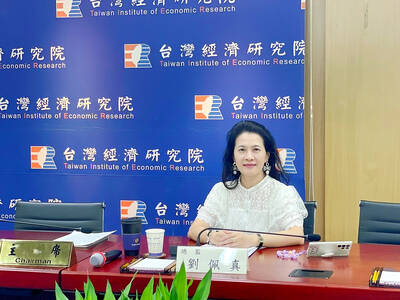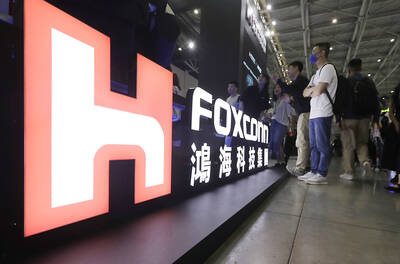With research groups at home and abroad lowering their global GDP growth forecasts for next year, domestic manufacturers and service providers have become gloomier in their business outlook, a survey by a local think tank showed yesterday.
The Taiwan Institute of Economic Research (TIER, 台經院), which surveys different sectors monthly on business sentiment, said the index for the manufacturing industry had dropped 10.61 points to 88.13 points last month, the lowest since the body initiated the poll in March 1979.
The service sector was less pessimistic, shedding 4.04 points to 94.34 points last month, from 98.38 points a month earlier, the TIER report showed.
Chen Miao (陳淼), a TIER researcher, said the number of manufacturers with a bearish outlook had risen 17.3 percent last month, while neutralists increased from 31.5 percent to 34.4 percent.
Chen said the global economic downturn had dented demand for Taiwan-made goods and squeezed manufacturers’ earnings.
Exports, the nation’s main driver of economic growth, declined 8.3 percent last month, with the falling trend expected to persist until the final quarter of next year, government figures showed.
“That explains why respondents with a bullish outlook hit a record low of 3 percent,” Chen told a media briefing.
The economist said the service industry did not fare any better, with the benchmark TAIEX plunging 14.84 percent and the New Taiwan dollar weakening 2.3 percent last month, while raw material prices remained high over the same period.
TIER president David Hong (洪德生) said the lack of public confidence compounded the financial malaise — despite a string of stimulus measures implemented by the government.
The government has announced a spate of stimulus packages worth billions of NT dollars to expand domestic demand through borrowing.
“Recovery may prove evasive as long as the United States and Europe remain shrouded in recession,” Hong said, adding that exports accounted for more than 60 percent of the nation’s GDP.
Analysts at Fubon Financial Holding Co (富邦金控) expressed similar views.
Rick Lo (羅瑋), senior vice president of macroecnomic research at Fubon Financial, said the financial crisis was now under control, thanks to a concerted effort by major countries. However, it would take 12 to 18 months for the damage done to the global economy to heal, he said.
“The key to global recovery lies in the US economy,” Lo said. “It has to pick up before other countries can follow suit.”
To that end, Lo said, the greenback had to remain strong and US real estate prices would have to stop falling.
Julia Chen (陳艾儒), vice president at Fubon Securities Investment Services Co (富邦投顧), said that while different research bodies put the GDP growth forecast for Taiwan at between 1.5 percent and 3 percent for next year, even achieving those goals would be insignificant.
“Investors may seek shelter in time and savings deposits before recovery, but doing so promises little profit,” Julia Chen said.
Cindy Yu (尤敏君), vice president at Taipei Fubon Bank (台北富邦銀行), said central banks worldwide would continue to loosen monetary policy and cut interest rates later this year and the first half of next year.
Yu said she expected the central bank to cut the discount rate by another 25 basis points next month and lower it to 2 percent next year from the current 2.75 percent.

A proposed 100 percent tariff on chip imports announced by US President Donald Trump could shift more of Taiwan’s semiconductor production overseas, a Taiwan Institute of Economic Research (TIER) researcher said yesterday. Trump’s tariff policy will accelerate the global semiconductor industry’s pace to establish roots in the US, leading to higher supply chain costs and ultimately raising prices of consumer electronics and creating uncertainty for future market demand, Arisa Liu (劉佩真) at the institute’s Taiwan Industry Economics Database said in a telephone interview. Trump’s move signals his intention to "restore the glory of the US semiconductor industry," Liu noted, saying that

On Ireland’s blustery western seaboard, researchers are gleefully flying giant kites — not for fun, but in the hope of generating renewable electricity and sparking a “revolution” in wind energy. “We use a kite to capture the wind and a generator at the bottom of it that captures the power,” said Padraic Doherty of Kitepower, the Dutch firm behind the venture. At its test site in operation since September 2023 near the small town of Bangor Erris, the team transports the vast 60-square-meter kite from a hangar across the lunar-like bogland to a generator. The kite is then attached by a

Foxconn Technology Co (鴻準精密), a metal casing supplier owned by Hon Hai Precision Industry Co (鴻海精密), yesterday announced plans to invest US$1 billion in the US over the next decade as part of its business transformation strategy. The Apple Inc supplier said in a statement that its board approved the investment on Thursday, as part of a transformation strategy focused on precision mold development, smart manufacturing, robotics and advanced automation. The strategy would have a strong emphasis on artificial intelligence (AI), the company added. The company said it aims to build a flexible, intelligent production ecosystem to boost competitiveness and sustainability. Foxconn

Leading Taiwanese bicycle brands Giant Manufacturing Co (巨大機械) and Merida Industry Co (美利達工業) on Sunday said that they have adopted measures to mitigate the impact of the tariff policies of US President Donald Trump’s administration. The US announced at the beginning of this month that it would impose a 20 percent tariff on imported goods made in Taiwan, effective on Thursday last week. The tariff would be added to other pre-existing most-favored-nation duties and industry-specific trade remedy levy, which would bring the overall tariff on Taiwan-made bicycles to between 25.5 percent and 31 percent. However, Giant did not seem too perturbed by the